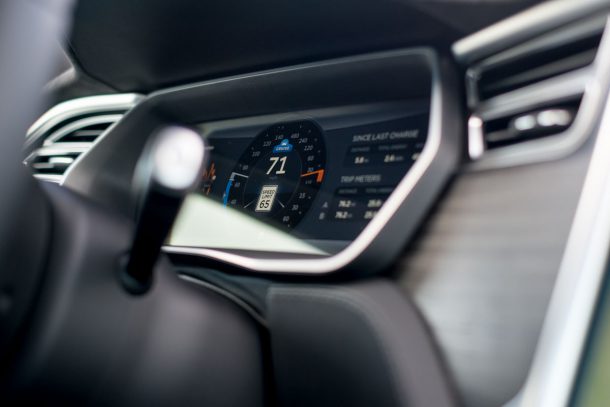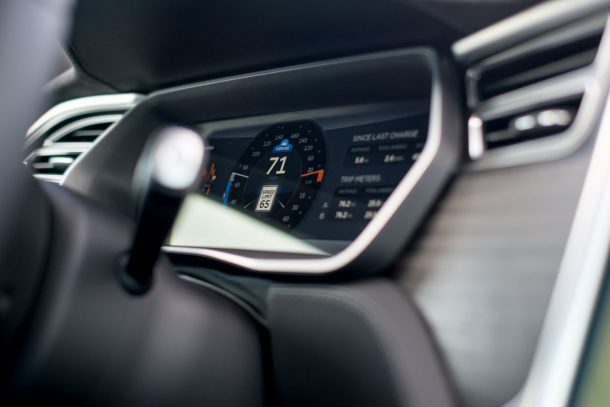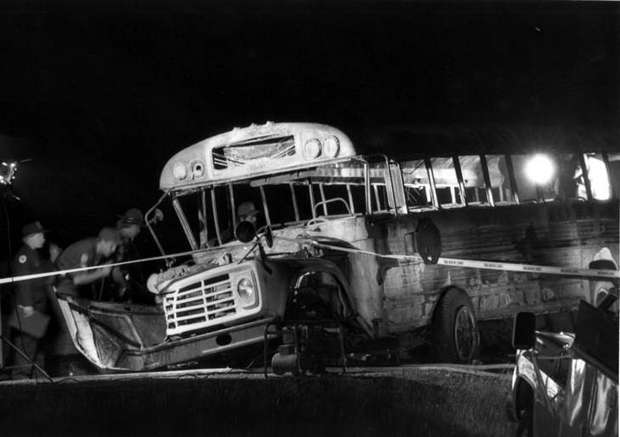#NTSB
Video of the Autonomous Uber Crash Raises Scary Questions, Important Lessons
On Wednesday evening, the Tempe Police Department released a video documenting the final moments before an Uber-owned autonomous test vehicle fatally struck a woman earlier this week. The public response has been varied. Many people agree with Tempe Police Chief Sylvia Moir that the accident was unavoidable, while others accusing Uber of vehicular homicide. The media take has been somewhat more nuanced.
One thing is very clear, however — the average person still does not understand how this technology works in the slightest. While the darkened video (provided below) does seem to support claims that the victim appeared suddenly, other claims — that it is enough to exonerate Uber — are mistaken. The victim, Elaine Herzberg, does indeed cross directly into the path of the oncoming Volvo XC90 and is visible for a fleeting moment before the strike, but the vehicle’s lidar system should have seen her well before that. Any claims to the contrary are irresponsible.
Unpacking the Autonomous Uber Fatality as Details Emerge [Updated]
Details are trickling in about the fatal incident in Tempe, Arizona, where an autonomous Uber collided with a pedestrian earlier this week. While a true assessment of the situation is ongoing, the city’s police department seems ready to absolve the company of any wrongdoing.
“The driver said it was like a flash, the person walked out in front of them,” explained Tempe police chief Sylvia Moir. “His first alert to the collision was the sound of the collision.”
This claim leaves us with more questions than answers. Research suggests autonomous driving aids lull people into complacency, dulling the senses and slowing reaction times. But most self-driving hardware, including Uber’s, uses lidar that can functionally see in pitch black conditions. Even if the driver could not see the woman crossing the street (there were streetlights), the vehicle should have picked her out clear as day.
Self-Driving Uber Vehicle Fatally Strikes Pedestrian, Company Halts Autonomous Testing
In the evening hours of March 18th, a pedestrian was fatally struck by a self-driving vehicle in Tempe, Arizona. While we all knew this was an inevitability, many expected the first casualty of progress to be later in the autonomous development timeline. The vehicle in question was owned by Uber Technologies and the company has admitted it was operating autonomously at the time of the incident.
The company has since halted all testing in the Pittsburgh, San Francisco, Toronto, and greater Phoenix areas.
If you’re wondering what happened, so is Uber. The U.S. National Transportation Safety Board (NTSB) has opened an investigation into the accident and is sending a team to Tempe. Uber says it is cooperating with authorities.
Operational Limits Played 'Major Role' in Fatal Tesla Autopilot Crash, Says NTSB
According to a preliminary report from the National Transportation Safety Board, the “operational limitations” of Tesla’s Autopilot system played “major role” in a highly publicized crash in May of 2016 that resulted in the death of a Model S driver.
On Tuesday, the NTSB cited the incident as a perfect storm of driver error and Tesla’s Autopilot design, which led to an over-reliance on the system’s semi-autonomous features. After a meeting lasting nearly three hours, the agency’s board determined probable cause of the accident was a combination of a semi truck driver failing to yield the right-of-way, the Tesla driver’s unwillingness to retake the wheel, and Tesla’s own system — which may have set the framework for the accident.
Tesla's Autopilot Alerted Driver to Retake Wheel Seven Times Prior to Fatal Crash
The National Transportation Safety Board has finally concluded its investigation into a May 2016 crash in Florida that resulted in the death of 40-year-old Joshua Brown. The ex-Navy SEAL’s Tesla Model S was operating in Autopilot mode when it collided with a semi trailer, raising speculation that the semi-autonomous driving feature was the reason for the accident.
While Tesla has repeatedly called the system a lane-keeping “assist feature” and suggested drivers always keep their hands on the wheel, consumer safety groups have urged the automaker to improve it.
An earlier investigation by the National Highway Traffic Safety Administration stated in January that the Autopilot software in Brown’s car did not have any safety defects. However, the NTSB stated that data acquired from the vehicle’s computer indicated that neither the vehicle nor its operator made any attempt to avoid the truck. It also specified that the vehicle had issued seven warnings for Brown to retake the wheel.
In the 37 minutes leading up to the fatal crash, the report said the car detected hands on the steering wheel for a total of 25 seconds.
Driver in Fatal Tesla Crash Was Speeding While on Autopilot: NHTSA
The National Transportation Safety Board didn’t assign any blame in its initial report into the fatal May 7 crash of a Tesla Model S, but did confirm new details.
The agency claims Joshua Brown’s vehicle was in Autopilot mode at the time of the crash, and was travelling above the 65 mile per hour speed limit before colliding with a tractor-trailer, according to Reuters.
Don't Blame Autopilot for That Pennsylvania Tesla Crash, Says Musk
Tesla’s Autopilot system is many things to many people — an automated folk devil to safety and consumer advocates, or a nice thing to have on a long drive ( according to Jack Baruth) — but it isn’t the cause of a July 1 rollover crash on the Pennsylvania Turnpike.
The automaker’s CEO took to Twitter yesterday to claim that the Model X driven by a Michigan man wasn’t even in Autopilot mode at the time of the crash. Elon Musk said that data uploaded from the vehicle shows that Autopilot wasn’t activated, and added that the “crash would not have occurred if it was on.”
Tesla then released those digital logs to the media.
Do Automated Safety Aids Make Drivers Complacent? The NTSB Wants to Know
The National Transportation Safety Board plans to investigate the fatal May 7 Tesla crash to see if the trend of increased automation in driving functions has a dark side, Bloomberg reports.
Already, the National Highway Traffic Safety Administration is looking into the incident and the role the vehicle’s semi-autonomous Autopilot system played in the crash, but the NTSB has a broader scope in mind. As vehicles increasingly rely on electronic aids for safety, drivers could be letting down their guard.
How Low Can You Go: NTSB Proposes Lowering BAC Limit to 0.05
Aftermath of Carrollton, KY bus crash May 14, 1988.
No one is in favor of drunk driving. Don’t do it. Now that I’ve completed the ritualistic incantation prior to writing a piece about drunk driving, let’s hit the jump and discuss the latest proposal from the NTSB.
Feds Push NY Towards Full Ban On Electronic Devices In Cars
Citing New York’s leadership in banning hand-held cell phone use in cars, NTSB Vice Chairman Christopher Hart urged the Empire State to become the first to ban all use of personal electronic devices while driving. Though careful to call it a state issue, Hart did hint that state compliance with forthcoming NTSB recommendations could be tied to federal highway funds (he has separately called for a national ban).
And indeed, New York’s legislators seemed to see the issue of distraction as an issue for federal action (but then, why not make the feds pay for it?). At the same time, everyone understands that the problem is near-ubiquitous and any full ban on personal device use in cars would be near-impossible to enforce (short of Assemblyman McDonough’s suggestion that automakers equip cars with cell-phone signal blockers)… which raises huge questions about federal-level action.
NTSB Pushing for Full Cell Phone Ban, Misses The Point
This is a guest article by our reader levaris. We wanted to see what the Best & Brightest think.
According to an Associated Press article today, the National Transportation Safety Board (NTSB) is recommending that States “should ban all driver use of cell phones and other portable electronic devices, except in emergencies”. How using a phone during an emergency is safer for the driver than when they aren’t calling about an emergency isn’t made clear, but that is not the biggest problem with this latest public safety cry.
The article mentions that this recommendation is made because of a crash in Missouri involving a semi cab (no trailer), a pickup truck, and two school buses. The driver of the pickup was killed, as was a student on one of the buses; a further thirty-eight people were injured.




![Unpacking the Autonomous Uber Fatality as Details Emerge [Updated]](https://cdn-fastly.thetruthaboutcars.com/media/2022/07/19/9193994/in-wake-of-crashes-public-confidence-in-self-driving-cars-pulls-a-u-turn.jpg?size=720x845&nocrop=1)





















Recent Comments